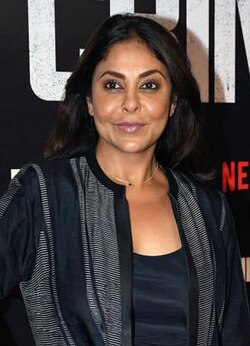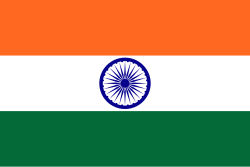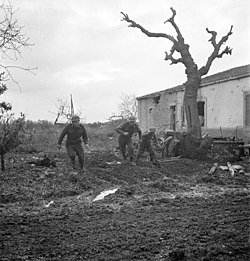Portal:India
Introduction


India, officially the Republic of India, is a country in South Asia. It is the seventh-largest country by area; the most populous country since 2023; and, since its independence in 1947, the world's most populous democracy. Bounded by the Indian Ocean on the south, the Arabian Sea on the southwest, and the Bay of Bengal on the southeast, it shares land borders with Pakistan to the west; China, Nepal, and Bhutan to the north; and Bangladesh and Myanmar to the east. In the Indian Ocean, India is near Sri Lanka and the Maldives; its Andaman and Nicobar Islands share a maritime border with Thailand, Myanmar, and Indonesia. (Full article...)
Selected pictures

The Eden Gardens is a cricket ground in Kolkata, India. It is one of the main international cricket venues of India and often called the "Mecca of Indian cricket". It is the home of the Bengal cricket team and the Kolkata Knight Riders, as well as being a Test, One Day International (ODI) and Twenty20 International (T20I) venue. As of 2020, the Eden Gardens has hosted more than 40 Test matches, the first of which was in January 1934 when India played the touring England team. These include the first ever day/night Test match in India which was hosted between 22 and 24 November 2019, when India played the visiting Bangladesh team. The first ODI played at the ground was between India and Pakistan on 18 February 1987. As of 2020, 30 ODIs have been played at the ground.
The first Test century scored at the ground was in December 1948, by Everton Weekes of the West Indies. He scored 162 runs in the first innings. In the same match Syed Mushtaq Ali of India scored 106 in the fourth innings, thus becoming the first Indian to have scored a century at the Eden Gardens. To date, 77 Test centuries have been scored at the ground. VVS Laxman's 281, scored against Australia in March 2001, during the famous second test of Border-Gavaskar Trophy, is the highest individual Test score achieved at the ground. The highest individual Test score by an overseas player is 256, scored by Rohan Kanhai of the West Indies in December 1958. Mohammad Azharuddin and VVS Laxman have scored five Test centuries each, the highest number of Test centuries scored by an individual player at the ground. During the second Test of the India–South Africa Test series held in February 2010 at the ground, a total of seven centuries were scored between the two teams. This is the highest number of centuries scored in a single Test match at the ground. (Full article...)
The work of most high courts primarily consists of adjudicating on appeals from lower courts and writ petitions in terms of Articles 226 and 227 of the Constitution. Writ jurisdiction is also the original jurisdiction of a high court. (Full article...)

Queen is a 2013 Indian comedy-drama film directed by Vikas Bahl and produced by Anurag Kashyap and Vikramaditya Motwane. The film stars Kangana Ranaut in the lead role, and features Rajkummar Rao and Lisa Haydon in supporting roles. The film was edited by Abhijit Kokate and Kashyap, and the cinematography was provided by Bobby Singh. Amit Trivedi composed the musical score for the film. Queen tells the story of Rani, an under-confident woman, who embarks on her honeymoon alone after her fiancé calls off their wedding.
Made on a budget of ₹125 million (US$1.5 million), Queen was released on 7 March 2014, and grossed ₹970 million (US$11 million) worldwide. The film garnered awards and nominations in several categories, with particular praise for its direction, performance of Ranaut, cinematography, and editing. As of June 2015, the film has won 32 awards. (Full article...)

A One Day International (ODI) is an international cricket match between two teams, each having ODI status, as determined by the International Cricket Council. The women's variant of the game is similar to the men's version, with minor modifications to umpiring and pitch requirements. The first women's ODI was played in 1973, between England and Australia. The Indian women's team played their first ever ODI match in 1978, against England, after the Women's Cricket Association of India was formed. The Women's Cricket Association of India was merged with the Board of Control for Cricket in India in 2006 as part of the International Cricket Council's initiative to develop women's cricket.
Since the team was formed, 151 women have represented India in ODI cricket. This list includes all players who have played at least one ODI match and is arranged in the order of debut appearance. Where more than one player won their first cap in the same match, those players are listed alphabetically by last name at the time of debut. (Full article...)

In cricket, a five-wicket haul (also known as a "fifer") refers to a bowler taking five or more wickets in a single innings. This is regarded as a notable achievement, and as of October 2024[update], only 54 bowlers have taken 15 or more five-wicket hauls at international level in their cricketing careers. A right-arm off break bowler, Harbhajan Singh has taken 417 wickets in Test, 269 wickets in One Day International (ODI) and 25 wickets in Twenty20 International (T20I) matches for India. He has the second-highest number of five-wicket hauls (28) in international cricket—next to Anil Kumble—among Indian cricketers and the eleventh among overall.
Harbhajan made his Test debut against Australia in 1998. His first five-wicket haul came against the same team during the second Test of the 2000–01 series at Eden Gardens. His six wickets for 73 runs in the second innings of the match raised his tally to thirteen wickets in the match; his performance was instrumental in India winning the match after being forced to follow-on. In the third Test of the series, he claimed fifteen wickets for 217 runs, including career-best figures of eight wickets for 84 runs. The majority of his five-wicket hauls in Test cricket—seven out of his twenty-five—have come against Australia. (Full article...)

The chief justice of India is the highest-ranking officer of the Indian judiciary and the chief judge of the Supreme Court of India. As head of the Supreme Court, the chief justice is responsible for the allocation of cases and appointment of constitutional benches which deal with important matters of law. In accordance with Article 145 of the Constitution of India and the Supreme Court Rules of Procedure of 1966, the chief justice allocates all work to the other judges.
A new chief justice is appointed by the president of India with recommendations by the outgoing chief justice in consultation with other judges. The chief justice serves in the role until they reach the age of sixty-five or are removed by the constitutional process of impeachment. As per convention, the name suggested by the incumbent chief justice is almost always the next senior-most judge in the Supreme Court. This convention has been broken twice: in 1973, Justice A. N. Ray was appointed superseding three senior judges and in 1977, Justice Mirza Hameedullah Beg was appointed as the chief justice superseding Justice Hans Raj Khanna. (Full article...)

In the Republic of India, a chief minister is the head of government of each of the twenty-eight states and three of the eight union territories. According to the Constitution of India, at the state level, the governor is de jure head, but de facto executive authority rests with the chief minister. Following elections to the State Legislative Assembly, the governor usually invites the party (or coalition) with a majority of seats to form the state government. The governor appoints the chief minister, whose council of ministers are collectively responsible to the assembly. Out of the thirty incumbents, except Tamil Nadu's M. K. Stalin, all other chief ministers also act as the leader of the house in their legislative assemblies. Given they have the assembly's confidence, the chief minister's term is usually for a maximum of five years; there are no limits to the number of terms they can serve.
Mamata Banerjee the Chief Minister of West Bengal, who has the longest continuous incumbency serving since 20 March 2011 (for 14 years, 60 days) and Rekha Gupta of Delhi are the only two incumbent female Chief Ministers. (Full article...)

The Victoria Cross (VC) was introduced in Great Britain on 29 January 1856 by Queen Victoria to reward acts of valour during the Crimean War. For the Indian Mutiny (also known as India's First War of Independence, Revolt of 1857, or the Sepoy Mutiny) the VC was awarded to 182 members of the British Armed Forces, the Honourable East Indies Company (HEIC) and civilians under its command. The VC is the highest British honour and is awarded for valour "in the face of the enemy". Created in 1856 for the British Army and Royal Navy, eligibility was extended in 1857 to members of the HEIC and in 1858 to non-military personnel bearing arms as volunteers.
Queen Victoria created the tradition of the British monarch presenting the VC to the recipient, personally presenting 74 of the 111 awards for the Crimean War. Many VCs for the Indian Mutiny were sent to India for presentation and while there is documentation for 42 presentations, the information on 51 presentations which were likely presented in India is vague and it not known if the medal was personally presented or received by post. There were 18 Indian Mutiny VCs sent to next of kin where the award was posthumous, or the recipient died before presentation. The Queen personally presented 63 Indian Mutiny awards after the recipients returned to the UK. (Full article...)
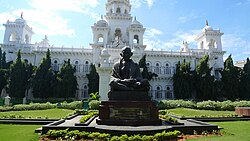
The Telangana Legislative Assembly is the lower house of the bicameral state legislature of Telangana state in India. It is housed in the Assembly Building, in Hyderabad, the capital of the state. The term of the assembly is five years, unless it is dissolved early.
Telangana was formed on 2 June 2014, after the passage of the Andhra Pradesh Reorganisation Act. It comprised 10 districts of Andhra Pradesh. The unified Legislative Assembly was also apportioned and 119 constituencies were assigned to the Legislative Assembly of the new state. The representatives of those constituencies, elected in the 2014 Andhra Pradesh Legislative Assembly election, became the members of the new assembly. Telangana has continued to have the same number of constituencies in the subsequent elections of 2018 and 2023. (Full article...)

Raveena Tandon is an Indian actress known for her work in Hindi films. She made her acting debut in the 1991 action film Patthar Ke Phool, which earned her the Filmfare Award for New Face of the Year. This was followed by a series of unsuccessful films including Ek Hi Raasta and Parampara (both 1993). In 1994, she appeared in eight Hindi films, most of them were commercial successes. Among these were two of the top-grossing films – the romantic musical drama Dilwale and the action drama Mohra. The success of the latter marked a turning point in her career, establishing Tandon as a leading actress in Hindi cinema. The same year, her performance in the drama Laadla, earned her a nomination for the Filmfare Award for Best Supporting Actress. Her other film was the comedy Andaz Apna Apna, which though initially a box office disappointment, attained cult status over the years.
Tandon subsequently played leading roles in the action thrillers Khiladiyon Ka Khiladi (1996) and Ziddi (1997). Both films were among the highest grossing Bollywood films of their respective years. In 1998, she starred opposite Govinda in the commercially successful comedies Dulhe Raja, and Bade Miyan Chote Miyan. Tandon had five film releases in 1999. While the comedy Anari No.1 was a commercial success, her other four releases that year performed poorly at the box office. Nevertheless, she received praise for her performance in the crime drama Shool. (Full article...)

Ayushmann Khurrana is an Indian actor, playback singer and television host who works in Hindi films. Khurrana first appeared in 2004 teen drama reality show MTV Roadies, winning the second season of the show. He went to star in many other MTV shows, including MTV Fully Faltoo Movies, Cheque De India and Jaadoo Ek Baar, and hosted multiple television shows, including India's Got Talent and Music Ka Maha Muqqabla. In 2012, he made his feature film debut with the romantic comedy Vicky Donor, about sperm donation, which received critical acclaim and performed strongly at the box office. Khurrana won the Filmfare Award for Best Male Playback Singer (for the song "Pani Da Rang"). He then starred in a series of commercially unsuccessful films, including the comedy-drama Nautanki Saala (2013), romantic comedy Bewakoofiyaan (2014), and drama Hawaizaada (2015).
In 2015, Khurrana starred in the Sharat Katariya-directed romantic drama Dum Laga Ke Haisha opposite Bhumi Pednekar. His performance was praised, and the film emerged as a commercial success. He then starred in Meri Pyaari Bindu (2017), Bareilly Ki Barfi (2017), and Shubh Mangal Saavdhan (2017). The latter two were commercially successful. In 2018, he starred in the black comedy Andhadhun and the comedy-drama Badhaai Ho. The former grossed ₹4.56 billion (US$64 million) worldwide, and became one of Indian cinema's biggest grossers; for his performance he won the National Film Award for Best Actor (shared with Vicky Kaushal for Uri: The Surgical Strike) and the Filmfare Critics Award for Best Actor. Badhaai Ho became a sleeper hit, earning over ₹2.21 billion (US$31 million) worldwide. This success continued with Khurrana's 2019 releases, Article 15, Dream Girl, and Bala. For the first of these, he won the Filmfare Critics Award for Best Actor. In the comedy Bala, he played a man plagued with premature balding. (Full article...)

Mohabbatein (transl. Love Stories) is a 2000 Indian Hindi-language musical romantic drama film written and directed by Aditya Chopra. It stars an ensemble cast of Amitabh Bachchan, Shah Rukh Khan, Aishwarya Rai, and the newcomers Uday Chopra, Shamita Shetty, Jugal Hansraj, Kim Sharma, Jimmy Sheirgill, and Preeti Jhangiani. It tells the story of a fictional all-boys college Gurukul's principal Narayan Shankar (Bachchan) who prohibits his students from falling in love and will unhesitantly expel those who do not obey the rule. The rest of the film focuses on how the arrival of the violin teacher Raj Aryan Malhotra (Khan) changes his views. Mohabbatein's soundtrack was composed by Jatin–Lalit, and the lyrics were written by Anand Bakshi. The film was shot by Manmohan Singh on sets designed by Sharmishta Roy, while the editor was V. Karnik.
The film opened at theatres on 27 October 2000 and was met with widespread acclaim from critics, who praised the performances of Bachchan and Khan. Made on a production budget of ₹130 million (US$1.5 million), the film had a total gross of ₹900.1 million (US$11 million) becoming the year's highest-grossing Indian film. (Full article...)

Manisha Koirala is a Nepalese actress known for her work in Hindi and Tamil films. Koirala's acting debut was in the Nepali film Pheri Bhetaula (1989). Two years later, she made her Bollywood debut in Subhash Ghai's Saudagar, which was a commercial success. However, she followed this by appearing in a series of films which performed poorly at the box office, including First Love Letter (1991), Anmol (1993), and Dhanwan (1993). Koirala's career had a turnaround when she starred as the daughter of a freedom fighter in Vidhu Vinod Chopra's 1942: A Love Story (1994). Her performance was critically acclaimed and she earned a nomination for the Filmfare Award for Best Actress. The following year, Koirala received the Filmfare Critics Award for Best Actress, and the Filmfare Award for Best Actress – Tamil for playing a Muslim married to a Hindu during the 1992–1993 Bombay riots in the Mani Ratnam-directed Tamil drama Bombay (1995).
For playing the daughter of a mute and deaf couple in Sanjay Leela Bhansali's Khamoshi: The Musical (1996), Koirala garnered a second consecutive Filmfare Critics Award for Best Actress. She followed this with leading roles in Agni Sakshi (1996) and Gupt: The Hidden Truth (1997), which were among the highest-grossing Indian films of their respective years. She played a terrorist opposite Shah Rukh Khan in Dil Se.. (1998), the first Indian film to reach the top ten in the United Kingdom box office. However, Koirala's roles in films which performed poorly at the box office, such as Dil Ke Jharokhe Mein (1997), and Achanak (1998), led to a decline in her film career. She made her television debut in 2000 as the co-host of the game show Sawaal Dus Crore Ka with Anupam Kher. The show's poor ratings led to both Kher and Koirala being fired. For her role as a gangster's girlfriend in Ram Gopal Varma's 2002 crime drama Company, she received her third Filmfare Critics Award for Best Actress. Koirala also appeared in the controversial film Ek Chhotisi Love Story in which she played a woman secretly spied upon by a teenage voyeur. The following year, her portrayal of Bengali writer Sushmita Banerjee in the drama Escape from Taliban garnered her the Bengal Film Journalists' Association Award for Best Actress (Hindi). (Full article...)

Indian actress Tabu appears primarily in Hindi, Telugu, and Tamil films. Her first credited role came as a teenager in Dev Anand's Hum Naujawan (1985), and her first major role was in the Telugu film Coolie No. 1 (1991). In 1994, Tabu received the Filmfare Award for Best Female Debut for the Hindi action drama Vijaypath, which marked her first of many collaborations with co-star Ajay Devgn. The year 1996 was key for Tabu. Her performance as a young woman affected by the Punjab insurgency in Gulzar's Maachis proved to be a breakthrough, winning her the National Film Award for Best Actress. Also that year, Tabu won the Filmfare Award for Best Actress – Telugu for the romance Ninne Pelladata, and featured alongside Govinda in the comedy film Saajan Chale Sasural.
Tabu had a brief role in the war film Border, the highest-grossing Hindi film of 1997, and portrayed a village girl opposite Anil Kapoor in the Priyadarshan-directed drama Virasat. Among her 1999 releases were two of the top-grossing Bollywood films of the year—the comedy Biwi No.1, and the family drama Hum Saath-Saath Hain. She also starred as the rebellious daughter of a corrupt politician in Gulzar's critically praised drama Hu Tu Tu (1999). The following year, she starred in Kandukondain Kandukondain, a Tamil adaptation of Sense and Sensibility, and played a submissive homemaker in the bilingual drama Astitva. Tabu garnered a second National Film Award for Best Actress for portraying a bar dancer in Madhur Bhandarkar's crime drama Chandni Bar (2001). In 2003, she starred in the Bengali film Abar Aranye, and portrayed a character based on Lady Macbeth, in Maqbool—an adaptation of Macbeth from Vishal Bhardwaj. Following a few commercial failures, Tabu played triple roles in M. F. Husain's musical drama Meenaxi: A Tale of Three Cities. Tabu's first international project came with Mira Nair's adaptation of Jhumpa Lahiri's novel The Namesake. In R. Balki's Cheeni Kum (2007), Tabu starred alongside Amitabh Bachchan as a woman romantically involved with a much older man; the role earned her a record fourth Filmfare Critics Award for Best Actress. (Full article...)

Vijay is an Indian actor, playback singer and politician who works in Tamil cinema. He made his cinematic debut in 1984 with Vetri, directed by his father, S. A. Chandrasekhar. After appearing in Chandrasekhar's films as a child artist, Vijay made his debut as a lead actor with Naalaiya Theerpu (1992) at the age of 18. He followed it with a role opposite Vijayakanth in Senthoorapandi (1993). Vijay went on to play lead roles in his father's directorial ventures such as Rasigan (1994), Deva (1995) and Vishnu (1995). Most of those films were successful commercially.
Vijay's first commercial blockbuster was the rom-com Coimbatore Mappillai in 1996, followed by his breakthrough blockbuster romance film, Poove Unakkaga. His subsequent films, Love Today (1997) and Kadhalukku Mariyadhai (1997), were critically and commercially successful. His performance in the latter won him the Tamil Nadu State Film Award for Best Actor. Thullatha Manamum Thullum (1999), where he played a passionate singer gained him the reputation of a romantic hero. (Full article...)

Haider is a 2014 Indian crime-drama film directed by Vishal Bhardwaj, and produced by Bhardwaj and Siddharth Roy Kapur. The film stars Shahid Kapoor as the eponymous protagonist, and co-stars Tabu, Kay Kay Menon, Shraddha Kapoor, and Irrfan Khan. Bhardwaj wrote the dialogues for the film, and co-wrote the screenplay with Basharat Peer. Bhardwaj also composed the music and Gulzar wrote the lyrics. The film is a modern-day adaptation of William Shakespeare's tragedy Hamlet, and tells the story of Haider who searches for his missing father during the Kashmir conflict of 1995.
Produced on a budget of ₹240 million (US$2.8 million), Haider was released on 2 October 2014, and grossed ₹690 million (US$8.2 million) worldwide. The film garnered awards and nominations in several categories, with particular praise for its direction, performances of Shahid Kapoor and Tabu, music and production design. As of June 2015, the film has won 36 awards. (Full article...)

Punjab Kings, formerly called Kings XI Punjab (KXIP), is a franchise cricket team based in Mohali, Punjab in India, and is one of the teams participating in the Indian Premier League (IPL). KXIP was founded in 2008. The franchise is owned by actress Preity Zinta, Ness Wadia of Bombay Dyeing, Karan Paul of the Apeejay Surendera Group and Mohit Burman of Dabur. The group paid US$76 million to acquire the franchise. It is owned by a consortium, along with the Rajasthan Royals. Along with the Rajasthan Royals, KXIP's franchise agreement was terminated by the Board of Control for Cricket in India (BCCI) in October 2010, because the teams had been signed by people who were not members of the consortium which owned the team. A petition of arbitration (appeal) was filed to the Bombay High Court in November 2010, challenging the decision, which was accepted a month later.
KXIP played their first Twenty20 match in 2008 during the first season of the IPL, where they reached the semi-final. They lost the 2008 semi-final to Chennai Super Kings on 31 May 2008, after playing fourteen matches in the league, winning ten matches and losing four. With ten international cricketers in 2009, they finished fifth in the second season of the IPL, winning and losing seven matches. KXIP finished in eighth place in the third IPL season, losing eleven of their fourteen matches. KXIP improved in the fourth season of the IPL, finishing in fifth place with seven losses and victories. In the IPL's fifth season in 2012, the team played sixteen matches, winning eight and losing nine to finish in sixth position. In the 2013 season, they won eight matches out of sixteen, and lost the other eight. In the 2014 season, they won 11 of 14 matches. In the 2015 season, KXIP won three of fourteen matches and finished in last position. In the IPL's ninth season, KXIP won four of fourteen matches and finished in last position. In the 2017 season, KXIP won seven of fourteen matches to finish in fifth position. (Full article...)
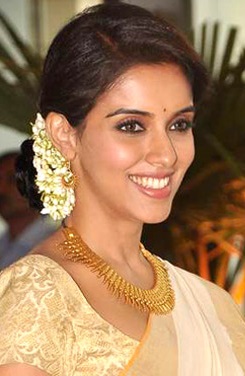
Asin is a former Indian actress who is known for her work in Tamil, Telugu and Hindi language films. She made her acting debut at the age of 15 in the Malayalam-language satirical comedy-drama Narendran Makan Jayakanthan Vaka in 2001. Asin had her first commercial success with the Telugu film Amma Nanna O Tamila Ammayi (2003). For her performance as a Tamil girl in the film, she received the Filmfare Best Telugu Actress Award. In the same year she won the Santosham Best Actress Award for her role in Telugu film Sivamani. In her next two Telugu releases: Lakshmi Narasimha (2004) and Gharshana (2004), Asin played the love interest of a police officer. Lakshmi Narasimha was a commercial success, while Gharshana received mixed reviews from critics but later gained a cult following.
She made her debut in Tamil cinema in the 2004 sports drama M. Kumaran Son of Mahalakshmi, a commercial success. The 2005 action thriller Ghajini marked a turning point in her career. Her role as a vivacious young model named Kalpana won her the Filmfare Best Tamil Actress Award. This led to a series of lead roles in commercially successful films, including the action film Sivakasi (2005), the thriller Varalaru (2006), the action thriller Pokkiri (2007), the action drama Vel (2008) and the science fiction film Dasavathaaram (2008), which established her as a leading actress of Tamil cinema. (Full article...)

The Indian National Defence Academy (NDA) is the joint services academy of the Indian Armed Forces, where cadets of the three armed forces (the Army, the Navy and the Air Force) train together before beginning pre-commission training at their respective service academies (Indian Military Academy (IMA), Indian Naval Academy (INA), and Air Force Academy (AFA) for army, navy, and air force cadets respectively). Established in 1954 and located in vicinity of Khadakwasla Dam, near Pune, it is the world's first tri-service academy.
NDA is not the only officer training academy in India. Besides NDA, which is tri-service academy, the Indian Army's IMA, Officers Training Academy (OTA), Army Cadet College (ACC), the Indian Navy's INA, and the Air Force's AFA are the other officer training academies of India. Besides cadets from NDA, these academies accept cadets separately from several streams. Apart from these, the Indian Army has three establishments for technical stream which include College of Military Engineering (CME), Military College of Telecommunication Engineering (MCTE), and Military College of Electronics and Mechanical Engineering (MCEME). Although cadets are imparted technical training at these three academies, they are commissioned through OTA, Gaya. Excluding all these establishments, which are meant for combat arms, the Indian Army has other commissioning academies for support services such as the Medical Corps, and the Judge Advocate General's Department for example. (Full article...)
News
- 15 July 2025 –
- A pick-up truck veers off a road in Pithoragarh, India, and plunges into a 300-meter gorge, killing eight people and injuring five others. (MSN)
- 10 July 2025 – Labour in India
- Sporadic clashes occur in East India between trade unionists and left-wing groups against police and Trinamool Congress supporters during a current general strike opposing the "Special Intensive Revision". (ABP)
- 9 July 2025 –
- At least thirteen people are killed and nine others are injured after a section of the Gambhira Bridge in Gujarat, India, partially collapses during morning rush hour. (The Times of India) (NDTV)
- 8 July 2025 –
- Ten people are killed and some others are injured when a fire and explosion cause eight rooms to collapse at a fireworks factory in Virudhunagar, Tamil Nadu, India. (The Star)
- 2 July 2025 – Quadrilateral Security Dialogue
- Australia, India, Japan, and the United States announce a joint initiative to work towards securing minerals necessary for new technologies and reduce reliance on Chinese sources. (DW) (The Guardian)
Did you know...
- ... that a 17th-century painting depicts an Indian emperor shooting arrows at a personification of poverty?
- ... that in its 1962 election campaign, the Socialist Party of India demanded that twice-yearly inter-caste dining be made a mandatory criterion for government employment?
- ... that independent India's first female pilot, Usha Sundaram, holds the record for the fastest flight between England and India in a piston-engine aircraft?
- ... that Karl Malte von Heinz designed the Vatican, Pakistani, Yugoslav and Thai diplomatic missions in India?
- ... that an Indian restaurant chain has more than 800 combinations of kulfi flavours, toppings, and sauces?
- ... that the horse Sardar was gifted to Jacqueline Kennedy during her 1962 goodwill tour of Pakistan?
Topics related to India
Timeline of Indian history, Indus Valley Civilisation, Dholavira, Science and technology in ancient India, Meluhha, Aryan invasion theory, Out of India theory, Greek conquests in India, Indian maritime history, Maurya Empire, Ashoka, Shunga Empire, Hoysala Empire, Vijayanagara, Satavahana dynasty, Indo-Greek Kingdom, Indo-Scythians, Indo-Parthian Kingdom, Kushan Empire, Western Satraps, Gupta Empire, Chola dynasty, Pala Empire, Islamic incursions in India, Mughal Empire, Maratha Empire, British Raj, East India Company, Governor-General, Viceroy, War of Independence, 1857, Indian independence movement, Indian National Army, Azad Hind, Quit India Movement, Partition of India, History of Republic of India, Non-Aligned Movement, Sino-Indian War, Indo-Pakistani War of 1947–1948, Indo-Pakistani War of 1965, Indo-Pakistani War of 1971, Kargil War, 2001–02 India–Pakistan standoff, Military, Demographic
Law, Hindu law, Constitution, Political parties (Indian National Congress, Bharatiya Janata Party), Foreign relations, Elections, Political divisions, Reservation in India
Government agencies, Legislative branch (Lok Sabha, Rajya Sabha) Executive branch (President & Vice President, Prime Minister & Deputy Prime Minister, Cabinet Ministers, Cabinet Secretary, Election Commission, Foreign Minister; Law enforcement: CBI, CID, Intelligence: IB, RAW), Directorate General of Income Tax Investigation Judicial branch (Supreme Court), Armed Forces (Army, Navy, Air Force, Border Security Force, Coast Guard)
Himalayas, Western Ghats, Eastern Ghats, Indo-Gangetic Plain, Deccan Plateau, Thar Desert, Ganges, Rann of Kutch, Brahmaputra River, Northeast India; Mountains, Valleys, Islands, Rivers; States and union territories, Cities, Districts, Regions, Fauna, Flora
Rupee, Bombay Stock Exchange, National Stock Exchange, Standard of living, Companies, Reserve Bank of India, Energy policy (Solar, Wind, Nuclear), Tourism, Transport (Expressways, Rail transport, Auto rickshaw),
Languages, Standard of living, Religion
Music (Carnatic, Hindustani, Indi-pop), Dance, Languages, Literature, Architecture, Film & TV, Cuisine, Holidays, Folklore, Education, Media, Indian martial arts
Indian Council of Agricultural Research (ICAR), Indian Institute of Astrophysics, National Centre for Software Technology, AIIMS, IISc, IIT, NIT, BITS-Pilani, INRegistry, Indian numbering system, Indian Space Research Organisation, National Internet Exchange of India, ICRISAT, International Institute of Information Technology, Hyderabad
Indian English, Indian nationality law, Numbering system, Indian Space Research Organisation, Telecommunications, National Highways Development Project, Flag, Vehicle registration plates, Indian nationalism, Metrication in India
Categories
Related portals
Religions in India
Indian Subcontinent
Other countries
Wikipedias in Indian languages
- অসমীয়া (Assamese)
- বাংলা (Bengali)
- भोजपुरी (Bhojpuri)
- বিষ্ণুপ্রিয়া মণিপুরী (Bishnupriya Manipuri)
- गोंयची कोंकणी / Gõychi Konknni (Konkani)
- ગુજરાતી (Gujarati)
- हिन्दी (Hindi)
- ಕನ್ನಡ (Kannada)
- कॉशुर/كشميري (Kashmiri)
- मैथिली (Maithili)
- മലയാളം (Malayalam)
- मराठी (Marathi)
- नेपाली (Nepali)
- नेपाल भाषा
- (Newari)
- ଓଡ଼ିଆ (Odiya)
- ਪੰਜਾਬੀ (Punjabi)
- पालि (Pali)
- संस्कृत (Sanskrit)
- ᱥᱟᱱᱛᱟᱲᱤ (Santali)
- سنڌي (Sindhi)
- தமிழ் (Tamil)
- తెలుగు (Telugu)
- ತುಳು (Tulu)
- اردو (Urdu)
Associated Wikimedia
The following Wikimedia Foundation sister projects provide more on this subject:
-
Commons
Free media repository -
Wikibooks
Free textbooks and manuals -
Wikidata
Free knowledge base -
Wikinews
Free-content news -
Wikiquote
Collection of quotations -
Wikisource
Free-content library -
Wikiversity
Free learning tools -
Wikivoyage
Free travel guide -
Wiktionary
Dictionary and thesaurus
- ^ In this Indian name, the name Krishnan is a patronymic, and the person should be referred to by the given name, Trisha.














